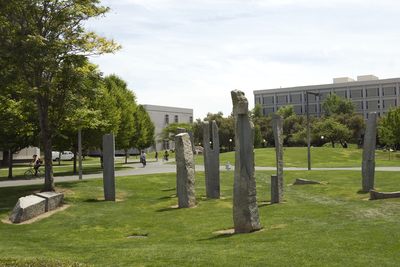INSTITUTIONAL COMMITMENT
GOAL 5: Ensure accountability to diversity and inclusion efforts on campus and in serving neighboring communities.
Underlying this goal is the belief that to make sustained, systemic change to our identity as an institution fostering inclusion excellence, UC Davis must embed the principles and goals of diversity and inclusion in every aspect of campus. As stated in the University of California Diversity Statement (Regents Policy 4400): “Diversity should … be integral to the University’s achievement of excellence.”

To realize the benefits of a community that embraces a diversity of cultures, experiences, and perspectives, we must strive to be an inclusive community. The vision this document imagines will require a concerted effort by all of us, from the newest student to the most senior administrator. Those in a position of leadership–at all levels–must direct their efforts to incorporate into the fabric of the university, the values and goals found in this strategic vision. Diversity and inclusion cannot be merely a “campaign” or an appendix to how the university views its mission but indivisible from it.
Essential to this goal of institutional commitment are the ideas of accountability and resource allocation. Accountability should have a broad range of meanings: transparency, access to data, and clear expectations of future success. The long-range commitment of resources–time, personnel, and funds–must be invested in these goals and objectives. This strategic vision provides an argument for the allocation of these resources for diversity and inclusion efforts so that they can be embedded into budgets and models of how the university operates.
The overall goal of this strategic plan is to create a guide that calls upon every member of the campus community to act as an ambassador of diversity and inclusion. The following objectives and strategies reflect steps to ensure that UC Davis delivers sustained attention to diversity and inclusion activity both within and beyond the institution, regardless of changes in leadership over time.
OBJECTIVES
- Identify and reward successful diversity and inclusion outcomes that lead to policy and procedures change. Develop a process to build financial and institutional sustainability into diversity and inclusion initiatives. Example: ADVANCE Sustainability Plan
- Expand opportunities for diversity and inclusion idea generation and innovation. Identify and commit resources and incentives for forming diverse teams and developing projects that advance diversity and inclusion ideas. Example: Diversity and Inclusion Innovation Grant Program
- Support a data governance team (experts in the business rules of the organization) to work with technologists (experts in the tools used to collect and report data) to improve the integrity of diversity data at UC Davis and take ownership of the Diversity Profiles data infrastructure project.
- Empower Human Resources to focus attention on proactive diversity and inclusion practices, including talent management, in developing and strengthening human relations skills and abilities in the campus community and workplace.
- Commit time and resources to catalog and coordinate initiatives and ideas; consult, coordinate and collaborate with schools, colleges, departments and units; sponsor performance measurement and otherwise promote and incentivize diversity and inclusion activities across the university.
- Develop and embed in all activities a communications plan on diversity and inclusion for the internal campus community. Examples: Diversity-themed, resource-rich websites at University of Oregon, UCLA, UC Berkeley, and University of Michigan
- Require every division, college, school, and department to create a measureable action plan based on this Diversity and Inclusion Strategic Vision and establish a budget line to ensure fulfillment of the action plan. Example: School of Veterinary Medicine, “Increasing Diversity—to Reflect California’s Population”
- Support and acknowledge divisions, schools, colleges, and departments that offer majors that attract diverse students, provide diversity curriculum for GE requirements, and offer seminars or courses that further cultural competency for students in other majors.
- Incorporate diversity in existing metrics (e.g., differential graduation rates) for annual reporting and calibrate them across each division, college, school, and department.
- Hold department-level leadership responsible for a systematic review of policies and procedures, both to ensure compliance and to align operations with diversity and inclusion goals and objectives.
- Establish professional standards and expectations for campus leadership to enhance and promote diversity and inclusion within their designated areas of responsibility and spheres of influence.
- Incorporate the role of equity and inclusion advisers to serve as resources in every division, college, school and department. Example: UCLA, UCSF, UC Irvine, and UC Berkeley
- Enlist departments and administrative units in a campaign to share and sustain campus values around diversity, inclusion, and social justice.
- Convene a UC Davis and neighboring communities task force charged to explore issues and coordinate diversity and inclusion activities between the university and neighboring communities.
- Pilot programs with UC Extension, the Mondavi Center, UC Davis museums, and other community-facing programs to provide customized courses and services that serve the region and enhance access to the university among the region’s most diverse and underserved communities (e.g., English language courses, college readiness programs, and telemedicine).
- Develop and pilot programs for family members of employees working at UC Davis that enhance access for first-generation college students and diverse communities.
- Create and circulate to regional public school districts and community centers a comprehensive inventory of existing UC and UC Davis programs and events that work with students and their families to ready them for college generally and for the opportunities at UC Davis specifically.
- In working with neighboring communities, develop a communications and engagement plan that will ensure that diversity and inclusion is a feature of any activity in which we collaborate.
Jump to:
Pipeline, Recruitment, and Retention
Climate
Research, Teaching, Public Service, and Training
You can download a PDF version of the plan here.
